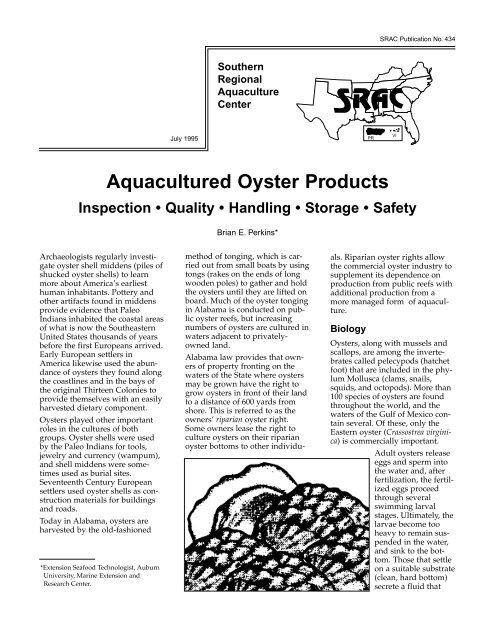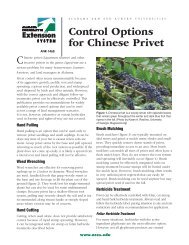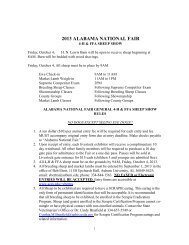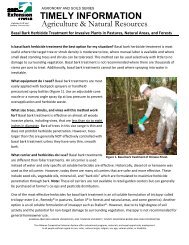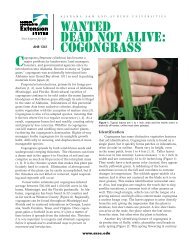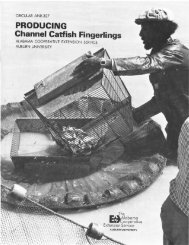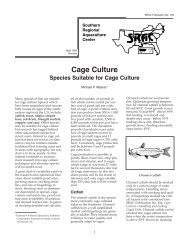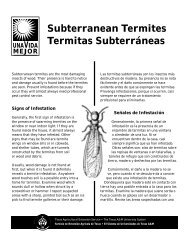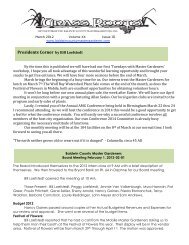aquacultured oysters - Alabama Cooperative Extension System
aquacultured oysters - Alabama Cooperative Extension System
aquacultured oysters - Alabama Cooperative Extension System
Create successful ePaper yourself
Turn your PDF publications into a flip-book with our unique Google optimized e-Paper software.
SRAC Publication No. 434<br />
Southern<br />
Regional<br />
Aquaculture<br />
Center<br />
July 1995<br />
PR<br />
VI<br />
Aquacultured Oyster Products<br />
Inspection • Quality • Handling • Storage • Safety<br />
Brian E. Perkins*<br />
Archaeologists regularly investigate<br />
oyster shell middens (piles of<br />
shucked oyster shells) to learn<br />
more about America’s earliest<br />
human inhabitants. Pottery and<br />
other artifacts found in middens<br />
provide evidence that Paleo<br />
Indians inhabited the coastal areas<br />
of what is now the Southeastern<br />
United States thousands of years<br />
before the first Europeans arrived.<br />
Early European settlers in<br />
America likewise used the abundance<br />
of <strong>oysters</strong> they found along<br />
the coastlines and in the bays of<br />
the original Thirteen Colonies to<br />
provide themselves with an easily<br />
harvested dietary component.<br />
Oysters played other important<br />
roles in the cultures of both<br />
groups. Oyster shells were used<br />
by the Paleo Indians for tools,<br />
jewelry and currency (wampum),<br />
and shell middens were sometimes<br />
used as burial sites.<br />
Seventeenth Century European<br />
settlers used oyster shells as construction<br />
materials for buildings<br />
and roads.<br />
Today in <strong>Alabama</strong>, <strong>oysters</strong> are<br />
harvested by the old-fashioned<br />
*<strong>Extension</strong> Seafood Technologist, Auburn<br />
University, Marine <strong>Extension</strong> and<br />
Research Center.<br />
method of tonging, which is carried<br />
out from small boats by using<br />
tongs (rakes on the ends of long<br />
wooden poles) to gather and hold<br />
the <strong>oysters</strong> until they are lifted on<br />
board. Much of the oyster tonging<br />
in <strong>Alabama</strong> is conducted on public<br />
oyster reefs, but increasing<br />
numbers of <strong>oysters</strong> are cultured in<br />
waters adjacent to privatelyowned<br />
land.<br />
<strong>Alabama</strong> law provides that owners<br />
of property fronting on the<br />
waters of the State where <strong>oysters</strong><br />
may be grown have the right to<br />
grow <strong>oysters</strong> in front of their land<br />
to a distance of 600 yards from<br />
shore. This is referred to as the<br />
owners’ riparian oyster right.<br />
Some owners lease the right to<br />
culture <strong>oysters</strong> on their riparian<br />
oyster bottoms to other individuals.<br />
Riparian oyster rights allow<br />
the commercial oyster industry to<br />
supplement its dependence on<br />
production from public reefs with<br />
additional production from a<br />
more managed form of aquaculture.<br />
Biology<br />
Oysters, along with mussels and<br />
scallops, are among the invertebrates<br />
called pelecypods (hatchet<br />
foot) that are included in the phylum<br />
Mollusca (clams, snails,<br />
squids, and octopods). More than<br />
100 species of <strong>oysters</strong> are found<br />
throughout the world, and the<br />
waters of the Gulf of Mexico contain<br />
several. Of these, only the<br />
Eastern oyster (Crassostrea virginica)<br />
is commercially important.<br />
Adult <strong>oysters</strong> release<br />
eggs and sperm into<br />
the water and, after<br />
fertilization, the fertilized<br />
eggs proceed<br />
through several<br />
swimming larval<br />
stages. Ultimately, the<br />
larvae become too<br />
heavy to remain suspended<br />
in the water,<br />
and sink to the bottom.<br />
Those that settle<br />
on a suitable substrate<br />
(clean, hard bottom)<br />
secrete a fluid that
cements them permanently to the<br />
bottom.<br />
Oysters eat by filtering food from<br />
the surrounding water through<br />
their gills. Under ideal conditions,<br />
an oyster can pump 5 gallons of<br />
water an hour through its filtering<br />
apparatus. <strong>Alabama</strong> <strong>oysters</strong><br />
reach harvestable size (3 inches)<br />
in 24 to 30 months.<br />
Inspection<br />
Because <strong>oysters</strong> cannot move,<br />
they are at the mercy of the surrounding<br />
environment. Along<br />
with their food (diatoms and<br />
algae), tides and currents can<br />
bring silt or sand to smother<br />
them, predators to feed on them,<br />
or microorganisms that they can<br />
accumulate and pass up the food<br />
chain. For this reason, state and<br />
federal health authorities pay<br />
close attention to molluscan shellfish.<br />
Like all other varieties of seafood,<br />
once <strong>oysters</strong> are landed at the<br />
dock or offered for import, they<br />
may be inspected by numerous<br />
authorities. Seafood inspection is<br />
not the continuous “carcass-bycarcass”<br />
inspection associated<br />
with red meat and poultry. Seafood<br />
is routinely inspected with a<br />
frequency determined by past experience<br />
or potential for a particular<br />
commodity to cause illness.<br />
State and county health authorities<br />
inspect all processing plants,<br />
grocery stores, and restaurants<br />
where seafood is processed, handled,<br />
or sold. The U.S. Food and<br />
Drug Administration (FDA)<br />
inspects seafood processing<br />
plants to ensure compliance with<br />
federal standards for sanitation,<br />
Good Manufacturing Practices,<br />
branding, and labeling. The FDA<br />
also checks seafood products for<br />
pesticides and other contaminants,<br />
and assures the wholesomeness<br />
of imported seafoods<br />
and products shipped across state<br />
lines.<br />
The FDA pays particularly close<br />
attention to raw, minimally<br />
processed, and ready-to-eat<br />
seafoods. Because <strong>oysters</strong>, clams,<br />
and mussels are often eaten raw,<br />
the FDA’s National Shellfish<br />
Sanitation Program (NSSP) carefully<br />
monitors them from their<br />
growing waters through processing,<br />
and ultimately to retail outlets.<br />
The NSSP Manual of<br />
Operations is routinely revised by<br />
the Interstate Shellfish Sanitation<br />
Conference (ISSC), a voluntary<br />
group composed of members<br />
from FDA, state health regulatory<br />
agencies, and industry. ISSC committees<br />
and task forces generate<br />
revisions and resolutions that are<br />
forwarded to FDA for approval.<br />
Once the revisions and resolutions<br />
are approved, FDA adds them to<br />
the NSSP Manual of Operations.<br />
Oysters may be placed in interstate<br />
commerce only if the growing<br />
state’s oyster industry and<br />
health agency practices are consistent<br />
with the NSSP Manual of<br />
Operations. State health agencies<br />
comply by routinely monitoring,<br />
classifying, and opening and closing<br />
shellfish growing and harvesting<br />
waters in the interest of consumer<br />
protection. Processors, in<br />
turn, attach tags to sacks or boxes<br />
of shellstock <strong>oysters</strong> (live <strong>oysters</strong><br />
in the shell) noting oyster harvest<br />
date and location. Processors must<br />
properly label containers and<br />
maintain strict temperature controls<br />
to minimize bacterial growth.<br />
Quality attributes and<br />
buying hints<br />
Like most seafoods, <strong>oysters</strong> provide<br />
sound nutrition. A 3 1 /2-<br />
ounce (100-gram) uncooked serving<br />
contains 7.9 grams of protein,<br />
3.5 grams of carbohydrate, 2<br />
grams of total fat, 57 milligrams of<br />
cholesterol, and 75 calories.<br />
Oysters are moderately low in<br />
sodium. A 3 1 /2-ounce serving<br />
also provides 100 percent of the<br />
USRDA for Vitamin B 12 and zinc,<br />
plus 65 percent of the USRDA for<br />
niacin, and about 35 percent of the<br />
USRDA for iron.<br />
Oysters are marketed live in the<br />
shell, as fresh, frozen or canned<br />
meats, or frozen and breaded.<br />
Live <strong>oysters</strong> are sold by the<br />
dozen, by the bushel bag, or in<br />
bushel-fraction boxes. Six live <strong>oysters</strong><br />
per person is a normal portion,<br />
although many people will<br />
eat more. Shucked oyster meats<br />
are graded and sold according to<br />
size, usually in 8-ounce and 12-<br />
ounce cups, or in pint, quart, or<br />
gallon containers. Allow 1 /3 to 1 /2<br />
pint of shucked oyster meats per<br />
serving.<br />
If you purchase <strong>oysters</strong> in the<br />
shell, make sure that they are<br />
alive. Live <strong>oysters</strong> hold their<br />
shells tightly closed. Tap any <strong>oysters</strong><br />
with slightly opened or<br />
“gaped” shells. Live <strong>oysters</strong> will<br />
respond by closing their shells<br />
tightly. Oysters that do not<br />
respond are dead and should be<br />
discarded. When purchasing<br />
freshly shucked oyster meats,<br />
choose <strong>oysters</strong> that are plump and<br />
have a natural creamy color and<br />
clear liquid.<br />
Raw molluscan shellfish should<br />
only be purchased from reputable<br />
dealers. All shellstock <strong>oysters</strong> are<br />
required to have an accompanying<br />
tag that allows the buyer to<br />
trace the <strong>oysters</strong> back to their<br />
point of harvest. Shucked oyster<br />
meats must be in sealed containers<br />
displaying the processor’s permit<br />
number. Retail-sized containers<br />
( 1 /2-gallon or smaller) of<br />
shucked oyster meats must have a<br />
“sell by” date stamped on them.<br />
Shucked oyster meat containers<br />
larger than 1 /2 gallon must display<br />
the “date shucked,” and cannot<br />
be offered for sale beyond 14<br />
days after that date. In-store “dipping”<br />
of oyster meats from larger<br />
containers into smaller cups is not<br />
legal in <strong>Alabama</strong>.<br />
Preparation<br />
Thoroughly wash and scrub all<br />
mud and debris away from the<br />
shells. This is best done with a<br />
garden hose and scrub brush. To<br />
shuck whole <strong>oysters</strong>, use gloves<br />
and an oyster knife. An oyster<br />
knife has a heavy wedge-shaped<br />
blade and handle, often made in<br />
one piece. It is designed to withstand<br />
the pressure required to<br />
open <strong>oysters</strong>. Never use a sharp<br />
knife.
The cleanest way to open <strong>oysters</strong><br />
is to grasp the oyster securely by<br />
the thin end or “bill,” leaving the<br />
hinge (thicker portion) exposed<br />
toward the other hand. Then:<br />
1. Insert the oyster knife into the<br />
crevice between the shells at<br />
the hinge; twist the knife<br />
while pushing it firmly into<br />
the opening to sever the<br />
hinge.<br />
2. Once the hinge is broken,<br />
before pulling the shell apart,<br />
slide the knife along the inside<br />
of the top shell to cut the<br />
adductor muscle loose from<br />
the top shell.<br />
3. Remove the top shell and slip<br />
the knife under the body of<br />
the oyster, being careful not to<br />
mutilate it, and cut the adductor<br />
muscle away from the bottom<br />
shell. Remove any<br />
remaining shell particles that<br />
may be attached to the oyster.<br />
Most <strong>oysters</strong>, except the very<br />
largest, can be opened by this<br />
method.<br />
An alternate method is to make an<br />
opening by breaking part of the<br />
shell on the thin end with a hammer.<br />
Insert the knife into the<br />
opening and slide along the inside<br />
of the top shell to cut the adductor<br />
muscle. Then cut the oyster meat<br />
away from the bottom shell being<br />
careful not to mutilate the oyster<br />
meat. (This method tends to leave<br />
more shell particles on the oyster.)<br />
Preservation<br />
Oysters to be eaten fresh can be<br />
stored in the refrigerator by either<br />
of two methods. Shellstock<br />
(unshucked) <strong>oysters</strong> can be stored<br />
without ice in ventilated containers<br />
in the refrigerator at 35-40° F,<br />
and should remain alive for 7 to<br />
10 days. Freshly shucked oyster<br />
meats can be placed in sanitized<br />
1-cup or 1-pint containers or plastic<br />
freezer bags. These containers<br />
or bags should be packed in ice<br />
and placed in the refrigerator.<br />
Oysters stored by this method will<br />
keep for 7 to 10 days.<br />
Oysters can be frozen, but they<br />
will be of lower quality than fresh<br />
<strong>oysters</strong>. The simplest method is to<br />
freeze <strong>oysters</strong> in the shell. Place<br />
the <strong>oysters</strong> in a plastic bag, press<br />
out excess air, seal the bag, and<br />
freeze. The shell and juices provide<br />
an excellent natural container<br />
for the oyster meat.<br />
Shucked oyster meats can be<br />
frozen also. They will maintain a<br />
better flavor if frozen in their own<br />
natural juices, called liquor. Place<br />
shucked oyster meats in sanitized<br />
plastic containers or freezer bags.<br />
Leave 1 /2 inch of headspace<br />
above oyster meats in plastic containers.<br />
Press freezer bags flat<br />
against oyster meats to expel<br />
excess air. Seal and freeze as<br />
quickly as possible.<br />
Oysters frozen by either of these<br />
two methods will keep for 2 or 3<br />
months. Do not thaw and refreeze<br />
<strong>oysters</strong>. Thaw overnight in refrigerator<br />
only. Thawing under running<br />
water washes away the flavor.<br />
It is best to use previously<br />
frozen oyster meats in preparations<br />
like oyster dressing, chowders,<br />
or stews where appearance<br />
is not so important.<br />
Safety<br />
Any protein food eaten raw poses<br />
a greater risk of causing illness<br />
than does the same protein food<br />
after cooking. However, commercially<br />
available <strong>oysters</strong> (and other<br />
molluscan shellfish) harvested<br />
from certified waters, packed<br />
under sanitary conditions in<br />
inspected facilities, and properly<br />
refrigerated pose little risk of<br />
causing disease when consumed<br />
raw by most healthy individuals.<br />
Along the Gulf Coast, we hear a<br />
great deal about seafood-related<br />
illnesses resulting from the bacterium,<br />
Vibrio vulnificus. This freeliving<br />
microbe occurs naturally in<br />
temperate brackish estuarine areas<br />
throughout the world. The numbers<br />
of Vibrio vulnificus in coastal<br />
waters increase during the<br />
warmer months. Thus, most cases<br />
of Vibriosis occur during late<br />
summer and early fall.<br />
One way Vibriosis can be contracted<br />
is by a puncture wound<br />
through which the Vibrio bacteria<br />
gain entry to the body. The disease<br />
can also be acquired by eating<br />
raw, undercooked, or minimally<br />
processed seafoods, including<br />
<strong>oysters</strong> and other molluscan<br />
shellfish. It can range in severity<br />
from a condition similar to (and<br />
commonly mistaken for) gastroenteritis,<br />
with associated nausea,<br />
vomiting, and diarrhea, to a lifethreatening<br />
primary septicemia.<br />
Everyone who eats seafood with<br />
associated Vibrio bacteria will not<br />
succumb to the illness. Among the<br />
groups of people who are more at<br />
risk are those with the following<br />
conditions:<br />
■ Achlorhydria (reduced stomach<br />
acidity)<br />
■ AIDS<br />
■ Cancer (especially patients<br />
undergoing chemotherapy)<br />
■ Chronic alcohol abuse<br />
■ Chronic kidney disease<br />
■ Diabetes mellitus<br />
■ Inflammatory bowel disease<br />
(or other diseases requiring<br />
immunosuppressive drugs)<br />
■ Liver disease (including cirrhosis<br />
and hemochromatosis)<br />
■ Steriod dependency (for such<br />
conditions as chronic obstructive<br />
pulmonary disease)<br />
To summarize oyster safety in<br />
simple terms, the commercial oyster<br />
industry and its related commodity<br />
organizations, along with<br />
county, state, and federal health<br />
agencies, assure that the vast<br />
majority of consumers will receive<br />
safe, wholesome, and nutritious<br />
<strong>oysters</strong>. Unfortunately, a certain<br />
portion of the population (listed<br />
previously) has a higher risk of<br />
succumbing to illness. Still, there<br />
are several steps that consumers<br />
can take to minimize the risk of<br />
illness:<br />
■ Since harmful microbes are<br />
killed by heat, high-risk individuals<br />
should enjoy <strong>oysters</strong><br />
and other molluscan shellfish<br />
cooked.
■ Persons who catch or harvest<br />
their own <strong>oysters</strong> should be<br />
certain that the waters from<br />
which they come are approved<br />
for harvest. County and state<br />
health authorities can provide<br />
advice about area openings and<br />
closings.<br />
■ Avoid cross-contamination<br />
between raw and cooked shellfish.<br />
Always sanitize raw product<br />
handling surfaces before<br />
placing cooked or ready-to-eat<br />
foods of any kind on the surface.<br />
■ If the <strong>oysters</strong> are to be cooked<br />
before consumption, be sure<br />
they are thoroughly cooked.<br />
Oyster meats are done when<br />
they plump and the edges<br />
begin to curl. (This occurs at a<br />
temperature of 140-150° F.)<br />
■ Refrigerate or freeze leftover,<br />
cooked oyster preparations<br />
promptly. Use refrigerated,<br />
cooked <strong>oysters</strong> within two<br />
days.<br />
REMEMBER: All raw foods,<br />
including <strong>oysters</strong>, contain bacteria.<br />
Handle <strong>oysters</strong> as you would<br />
any perishable food. Keep <strong>oysters</strong><br />
cold, handle oyster meats with<br />
clean hands on sanitized surfaces,<br />
and use older products first.<br />
Purchase <strong>oysters</strong> only from reputable,<br />
properly licensed or permitted<br />
outlets.<br />
Further reading<br />
The material in this fact sheet was<br />
compiled from information contained<br />
in the following publications.<br />
Consult them for additional<br />
information about oyster biology,<br />
management, nutrition, preparation,<br />
preservation, production,<br />
quality, and safety.<br />
Perkins, B.E. 1993. <strong>Alabama</strong><br />
seafood facts. <strong>Alabama</strong><br />
<strong>Cooperative</strong> <strong>Extension</strong> Service<br />
Circular ANR-833. MASGP-<br />
93-014.<br />
Wallace, R.K. 1993. Oysters in<br />
<strong>Alabama</strong>. <strong>Alabama</strong><br />
<strong>Cooperative</strong> <strong>Extension</strong> Service<br />
Circular ANR-832. MASGP-<br />
93-010.<br />
Wallace, R.K. 1993. Oyster farming<br />
in <strong>Alabama</strong>. <strong>Alabama</strong><br />
<strong>Cooperative</strong> <strong>Extension</strong> Service<br />
Circular ANR-805. MASGP-<br />
93-007.<br />
Perkins, B.E. 1991. Seafood safety.<br />
<strong>Alabama</strong> <strong>Cooperative</strong><br />
<strong>Extension</strong> Service Circular<br />
ANR-578. MASGP-91-003.<br />
Perkins, B.E. 1990. Preparation<br />
and preservation of <strong>Alabama</strong><br />
seafood. <strong>Alabama</strong> <strong>Cooperative</strong><br />
<strong>Extension</strong> Service<br />
Circular CRD-53. MASGP-90-<br />
005.<br />
Perkins, B.E. 1987. Saving your<br />
catch. <strong>Alabama</strong> <strong>Cooperative</strong><br />
<strong>Extension</strong> Service Circular<br />
CRD-40. MASGP-87-001.<br />
Hosking, W. and R.L. Collette.<br />
1984. Buying and preparing<br />
<strong>oysters</strong>. <strong>Alabama</strong> <strong>Cooperative</strong><br />
<strong>Extension</strong> Service Circular<br />
CRD-30. MASGP-84-003.<br />
This publication was supported in part by a grant from the United States Department of Agriculture,<br />
Number CSREES 93-38500-8393, sponsored jointly by the <strong>Cooperative</strong> State Research, Education,<br />
and <strong>Extension</strong> Service and the <strong>Cooperative</strong> <strong>Extension</strong> Service.


